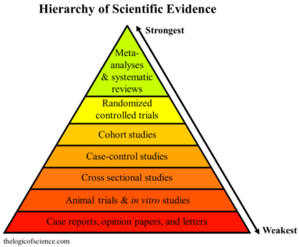Navigating through research can be intimidating and confusing. Especially if you don’t have a science background. There is a lot that goes into the writing of research that makes it hard to read. There are p values for statistical significance, there are charts and graphs that seem to be in a different language, there are plus and minus values, and LOTS of text.
I want to present some easy places you can find the most up to date research in the field of strength and conditioning and nutrition as well as teach you how to read the complex ones.
Before we begin, it is important to discuss the different types of research. The pyramid below covers the hierarchy of evidence.
Case Studies
Case reports or case studies are the lowest on the pyramid. They are typically a report on one individual and their response to an intervention. The problem with case reports, are they have a small sample size, have higher amount of bias, and don’t control variables as well as the higher forms of research on the pyramid. These are often the studies that you will find when someone reports an adverse reaction to an intervention or supplement when there are no other participants that were involved in the study.
The rest of the red and orange types of studies are good at identifying new variables that we should further research. They can show correlation between variables but lack the scientific rigor for coaches to take information from them and implement them into their training programs.
Randomized Controlled Trials
Randomized controlled trials (RCT) involve control groups and test groups that have been randomly put into their specific group. Most of the time the subjects don’t know what group they are in. RCTs are the meat and potatoes of the research world. This is where the work is being done to determine if an intervention is better than the current standard or placebo.
The problem with RCTs is that there is conflicting evidence in many studies. Some studies that share similar methods may have completely different results. That is why it is important to look up other research on the same topic after reading an RCT to see how it compares to past research. WE NEED MORE THAN ONE STUDY TO PROPOSE THAT SOMETHING WORKS.
Systematic Reviews and Meta-Analyses
Systematic reviews and meta-analyses are the next step. These are papers that combine findings from multiple RCTs to give you the most well-rounded picture of a topic is that has been researched. Here is where we can really take research and apply it to our coaching. Systematic reviews and meta-analyses are used to create practice guidelines that are used in all professions.
When looking at research, I typically suggest focusing most of your attention to systematic review, meta-analyses, and RCTs.
Resources I Use For My Research
Now on to the sites that I have found to be the most helpful for me to get my research. I’m going to start with the easiest ones to read first.
Greg Nuckols and his team do an amazing job of synthesizing the most current research for anyone to read into about a paragraph. There may be some charts included as well. This is an easy go to! They include strength training, hypertrophy, nutrition, and supplementation.
Examine allows you to search by supplement to find the outcomes from multiple studies. Here is an example below on beta-alanine. You see that the outcome that eight different studies tracked was muscular endurance. They found a very high correlation that there was a minor improvement in muscular endurance. The level of evidence bar is on the left which shows how much research has been done on the supplement. The higher the level of evidence, the more research that has bene done.
NSCA – Journal of Strength and Conditioning:
Here is where I go every month to search through abstracts for research to read. Abstracts give you a quick snapshot of what the article is about. It gives you the key findings, but not the whole story.
To get published in the NSCA’s Journal, the article has to be good quality. There are plenty of research that has been done but never gets published by journals because the research was not good. If the journal does not like how the research was conducted, they do not publish it.
[thrive_leads id=’10395′]
I use the NSCA but there are plenty of other sports medicine and strength and conditioning journal sites. If you are interested in subscribing, there is a monthly or annual fee that is associated with it. If you live close to a college campus sometimes you can get the articles for free by logging on through their library website or campus WI-FI.
Here is going to be your gold standard. With that, it is hard to read! You are going to have to read a lot to really understand what you are reading.
While searching for articles, make sure to search for systematic reviews or RCTs. You have the ability to filter by article type. It will narrow your search by quite a lot. Also look for articles that are recent (past 5-10 years).
If you are reading an RCT, it is important to really assess the methods section. Do the methods make sense? Is it reproducible? Are there too many factors that are at play here that could have contributed to the outcome? Be critical of the articles you read. Then read the results. From there, you can start to piece together your own conclusion. See if your conclusion matches the authors.
The systematic reviews are nice because the authors of the review have already been critical of all the RCTs. If in doubt read reviews. You can skip about how they found the RCTs for their paper.
Review Articles
There are some websites that will post review articles of recent research. These are also a great place to start. They are typically simplified and easier to read. Like “strengthandconditioningresearch.com”
Follow Researchers You Like On Social Media
One of the easiest ways to get the most up to date research is following researchers like Dr. Andy Galpin and Dr. Bret Contreras on social media. They post about their most recent publications and the results from them on Twitter and IG. If you find a research article that you really enjoy, look at the name of the Authors. From there you can search the names of the authors on Pubmed to find more of their research. Most researchers specialize in a specific field.
Listen to “151 – Andy Galpin on Advances in the Science of Strength” on Spreaker.https://widget.spreaker.com/widgets.js
A closing thought, be critical the next time someone tells you that “research shows ____ works better than ____.” You will be surprised of the limitations that research has. There are plenty of research articles that do not get published. For every article that supports something works, there will always be another article that says it does not work. You have to be critical and actually dig into the research to make your own opinions.
[thrive_leads id=’8207′]



This is a very useful article for me who is a layman and trying to separate fact from reality. Thank you for this very informative read!